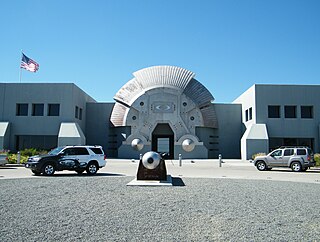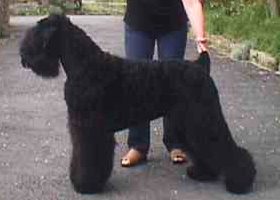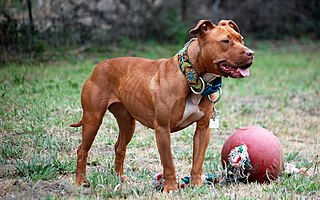
Glasses, also known as eyeglasses or spectacles, are vision eyewear with lenses mounted in a frame that holds them in front of a person's eyes, typically utilizing a bridge over the nose and hinged arms that rest over the ears.

Sunglasses or sun glasses are a form of protective eyewear designed primarily to prevent bright sunlight and high-energy visible light from damaging or discomforting the eyes. They can sometimes also function as a visual aid, as variously termed spectacles or glasses exist, featuring lenses that are colored, polarized or darkened. In the early 20th century, they were also known as sun cheaters.

The Jack Russell Terrier is a British breed of small terrier. It is principally white-bodied and smooth-, rough- or broken-coated, and can be any colour.
Photokeratitis or ultraviolet keratitis is a painful eye condition caused by exposure of insufficiently protected eyes to the ultraviolet (UV) rays from either natural or artificial sources. Photokeratitis is akin to a sunburn of the cornea and conjunctiva.

Oakley, Inc. is an American company headquartered in Foothill Ranch, California, which is an autonomous subsidiary of EssilorLuxottica. The company designs, develops and manufactures sports performance equipment and lifestyle pieces including sunglasses, safety glasses, eyeglasses, sports visors, ski/snowboard goggles, watches, apparel, backpacks, shoes, optical frames, and other accessories. Most items are designed in house at their head office, but some countries hold exclusive designs relevant to their market. Oakley currently holds more than 600 patents for eyewear, materials, and performance gear.

Ray-Ban is an American brand of luxury sunglasses and eyeglasses created in 1936 by Bausch & Lomb. The brand is known for its Wayfarer and Aviator lines of sunglasses. In 1999, Bausch & Lomb sold the brand to Italian eyewear conglomerate Luxottica Group for a reported $640 million.

The Boston Terrier is a breed of dog originating in the United States of America. This "American Gentleman" was accepted in 1893 by the American Kennel Club as a non-sporting breed. Color and markings are important when distinguishing this breed from the AKC standard. They should be either black, brindle or seal with white markings. Boston Terriers are small and compact with a short tail and erect ears. The AKC says they are highly intelligent and very easily trained. They are friendly and can be stubborn at times. The average life span of a Boston Terrier is around 11 to 13 years.

Goggles, or safety glasses, are forms of protective eyewear that usually enclose or protect the area surrounding the eye in order to prevent particulates, water or chemicals from striking the eyes. They are used in chemistry laboratories and in woodworking. They are often used in snow sports as well, and in swimming. Goggles are often worn when using power tools such as drills or chainsaws to prevent flying particles from damaging the eyes. Many types of goggles are available as prescription goggles for those with vision problems.

The Sealyham Terrier is a rare Welsh breed of small to medium-sized terrier that originated in Wales as a working dog. It is principally a white-bodied, rough-coated breed, developed in the mid-to-late-19th century by Captain John Edwardes at Sealyham House, Pembrokeshire.

The Black Russian Terrier, also known as the Chornyi Terrier, is a breed of dog created in USSR in Red Star Kennel during the late 1940s and the early 1950s for use as military/working dogs. At the present time, the Black Russian Terrier is a breed recognized by the FCI, AKC, CKC, KC, ANKC, NZKC and other cynological organizations. The contemporary Black Russian Terrier is a working dog, guarding dog, sporting and companion dog.

The American Pit Bull Terrier (APBT) is a dog breed recognized by the United Kennel Club (UKC) and the American Dog Breeders Association (ADBA), but not the American Kennel Club (AKC). It is a medium-sized, short-haired dog, of a solid build, whose early ancestors came from the British Isles. When compared with the English Staffordshire Bull Terrier, the American Pit Bull Terrier is larger by margins of 6–8 inches (15–20 cm) in height and 25–35 pounds (11–16 kg) in weight. The American Pit Bull Terrier varies in size: males are normally about 18–21 inches (45–53 cm) in height and around 35–60 pounds (15–27 kg) in weight, while females are normally around 17–20 inches (43–50 cm) in height and 30–50 pounds (13–22 kg) in weight.

Eye protection is protective gear for the eyes, and sometimes face, designed to reduce the risk of injury. Examples of risks requiring eye protection can include: impact from particles or debris, light or radiation, wind blast, heat, sea spray or impact from some type of ball or puck used in sports.

Mirrored sunglasses are sunglasses with a reflective optical coating on the outside of the lenses to make them appear like small mirrors. The lenses typically give the wearer's vision a brown or grey tint. The mirror coating decreases the amount of light passing through the tinted lens by a further 10–60%, making it especially useful for conditions of sand, water, snow, and higher altitudes. Mirrored sunglasses are one-way mirrors.

The Manchester Terrier is a breed of dog of the smooth-haired terrier type. It was first bred in the 19th century to control vermin, notably rats, at which it excelled. So efficient at the task was it that it often appeared in rat-baiting pits until that sport, which had effectively been illegal in the UK since 1835, finally died out at the beginning of the 20th century.

Aviator sunglasses are a style of sunglasses that were developed by a group of American firms. The original Bausch & Lomb design is now commercially marketed as Ray-Ban Aviators, although other manufacturers also produce aviator-style sunglasses.

Eyewear is a term used to refer to all accessories worn over both of a person's eyes, or occasionally a single eye, for one or more of a variety of purposes. Though historically used for vision improvement and correction, eyewear has also evolved into eye protection, for fashion and aesthetic purposes, and starting in the late 20th century, computers and virtual reality.
A circle contact lens, also known as a big eye contact lens and circle lens, is a cosmetic contact lens that makes the eye's iris appear larger. It has become a trend throughout East, South and Southeast Asia and is largely produced in Japan, South Korea and China.
Ballistic eyewear is a form of glasses or goggles that protect from small projectiles and fragments. For the U.S. military, choices are listed on the Authorized Protective Eyewear List (APEL). Ballistic eyewear including examples that meet APEL requirements are commercially available for anyone who wishes to buy it. The history of protective eyewear goes back to 1880 and extends through to World War I and the present. There are three standards that are currently used to test the effectiveness of ballistic eyewear. These include a U.S. civilian standard, a U.S. military standard (MIL-PRF-31013), and a European standard.

Chicken eyeglasses, also known as chicken specs, chicken goggles, generically as pick guards, and under other names, were small eyeglasses made for chickens intended to prevent feather pecking and cannibalism. They differ from blinders in that they allow the bird to see forward, whereas blinders do not. One variety used rose-colored lenses, as the coloring was thought to prevent a chicken wearing them from recognizing blood on other chickens, which may increase the tendency for abnormal injurious behavior. They were mass-produced and sold throughout the United States as early as the beginning of the 20th century.
Shred Optics is a manufacturer of sunglasses, helmets and goggles designed for skiing, mountain biking, snowboarding and other forms of outdoor recreation. The company is based in Park City, Utah, and Venice, Italy.


















